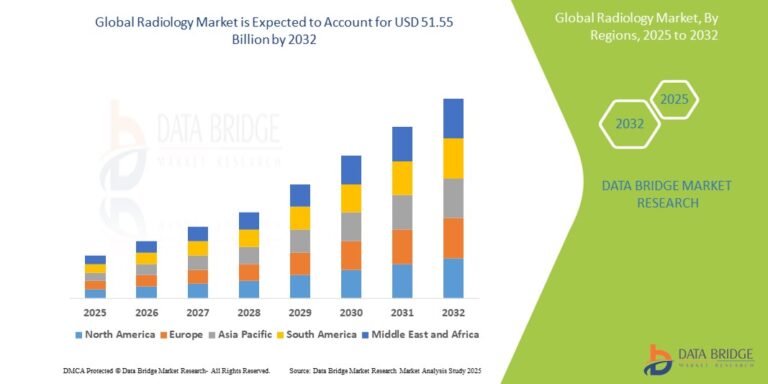Introduction
Radiology has long stood at the forefront of modern medicine, transforming how doctors detect, diagnose, and monitor diseases. Today, the global radiology market is evolving at an unprecedented pace, driven by technological innovation, rising demand for early diagnosis, and a growing focus on minimally invasive healthcare solutions. From advanced MRI scanners to AI-powered image analysis, radiology is helping shape the future of precision medicine.
Source : https://www.databridgemarketresearch.com/reports/global-radiology-market
What is Radiology?
Radiology is a medical specialty that uses various imaging technologies to visualize the inside of the body. Its purpose is to diagnose, monitor, and sometimes treat diseases and injuries. The field includes diagnostic imaging such as X-rays, CT scans, MRI, ultrasound, and nuclear medicine, as well as interventional radiology, which uses imaging to guide minimally invasive surgical procedures.
Key Segments of the Radiology Market
- Diagnostic Imaging: Includes X-ray, computed tomography (CT), magnetic resonance imaging (MRI), ultrasound, mammography, and nuclear imaging.
- Interventional Radiology: Combines imaging with minimally invasive techniques to treat conditions like blocked arteries, tumors, and aneurysms without open surgery.
- Radiology Information Systems (RIS) & Picture Archiving and Communication Systems (PACS): Digital solutions that help hospitals store, manage, and share medical images securely and efficiently.
- Artificial Intelligence (AI) & Machine Learning: AI tools assist radiologists in detecting anomalies faster and with greater accuracy.
Drivers of Market Growth
1. Rising Prevalence of Chronic Diseases: Aging populations and lifestyle-related diseases such as cancer, cardiovascular conditions, and neurological disorders are increasing the need for accurate and early diagnosis — the backbone of radiology.
2. Technological Advancements: The industry is experiencing rapid progress, with innovations like high-resolution 3D and 4D imaging, portable devices, and hybrid imaging technologies that combine modalities for better diagnostics.
3. Growth of Tele-Radiology: Telemedicine is extending the reach of radiology services to rural and underserved areas, allowing images to be captured locally and interpreted remotely by specialists.
4. Increasing Demand for Minimally Invasive Procedures: Interventional radiology enables treatments with smaller incisions, reduced hospital stays, and quicker recovery times, making it a preferred option for patients and healthcare systems alike.
5. Artificial Intelligence Integration: AI is revolutionizing radiology by automating routine tasks like image segmentation and anomaly detection, improving efficiency and diagnostic accuracy while reducing radiologists’ workload.
Regional Highlights
- North America: Dominates the market due to advanced healthcare infrastructure, high adoption of AI, and strong research funding.
- Europe: Significant growth driven by increasing investments in healthcare modernization and early cancer detection initiatives.
- Asia-Pacific: Expected to see the fastest growth due to rising healthcare spending, expanding medical tourism, and an increasing focus on improving diagnostic capabilities in emerging economies.
Trends Shaping the Future of Radiology
- AI-Powered Diagnostics: Deep learning algorithms are being trained to detect diseases like cancer, brain disorders, and cardiac conditions, sometimes outperforming human detection rates in speed and consistency.
- Portable and Point-of-Care Imaging: Compact ultrasound and handheld imaging devices are expanding diagnostic capabilities beyond traditional hospital settings.
- 3D & 4D Imaging: Advanced imaging techniques provide clearer, more detailed views, supporting precision treatment planning, particularly in oncology and orthopedics.
- Patient-Centric Care: Radiology is increasingly focused on enhancing patient experiences with faster scans, lower radiation doses, and personalized treatment plans.
- Big Data & Cloud Solutions: Integration of radiology data with electronic health records (EHRs) and cloud-based image sharing are improving collaboration among healthcare teams.
Challenges Facing the Market
- High Equipment Costs: Cutting-edge imaging machines like MRI and PET-CT scanners involve significant capital investments, which can limit adoption in low-resource settings.
- Skilled Workforce Shortage: There is a global shortage of trained radiologists and technicians, especially in rural or developing regions.
- Data Security Concerns: The increasing digitization of patient imaging data brings heightened risks of cyber threats and data breaches.
- Reimbursement and Regulatory Hurdles: Varying insurance coverage and complex regulations can slow down the adoption of new technologies.
Outlook for the Radiology Market
The radiology market is expected to grow steadily as technological breakthroughs, AI integration, and rising healthcare needs continue to drive demand. Companies that focus on user-friendly, cost-effective, and AI-enabled imaging solutions will shape the next era of radiology. Collaborations between technology firms, healthcare providers, and research institutions will further accelerate innovation and expand access to life-saving diagnostics worldwide.
Conclusion
Radiology is more than just images — it is a vital pillar of modern healthcare that enables early detection, informed treatment decisions, and better patient outcomes. As this market evolves, it holds the promise of transforming medical care through faster, more precise, and more accessible diagnostics for people everywhere. In a world where early detection can save lives, radiology remains at the heart of tomorrow’s healthcare.
https://penzu.com/journals/30882955/108781665
https://yulojk.blogspot.com/2025/07/leadless-cardiac-pacemaker-market.html
https://yulojk.blogspot.com/2025/07/intra-abdominal-pressure-measurement.html


